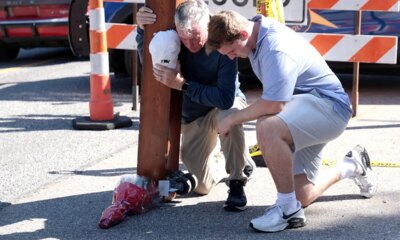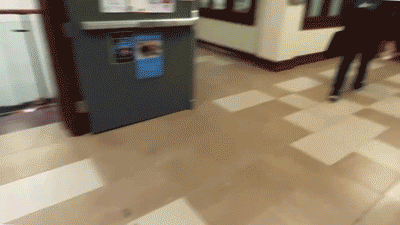California
More batteries, less solar: California's solar turmoil in charts

California slashed the value of rooftop solar for customers of its three biggest utilities last year — and installations of residential solar systems in the state have fallen to near-three-year lows since then.
But drawing firm conclusions about how the controversial shift in net-metering policy will shape California’s rooftop solar market over the long term — and affect the state’s grid-decarbonization and energy-equity goals — is a lot more complicated than it looks.
Just ask Galen Barbose, staff scientist at the Department of Energy’s Lawrence Berkeley National Laboratory. Last week, he released a report compiling the latest data on California’s residential rooftop solar market, including the data point showing a marked drop in installations in the first three months of 2024.
Barbose also scrutinized battery-storage attachment rates, the distribution of solar adopters by geography and income, third-party ownership, system sizing, pricing, and installer market share. The goal was to reveal “initial empirical insights into how the market has evolved over the past year, confirming some expectations while also revealing several striking surprises,” he wrote in the report.
But “we have to be careful about not overreaching from the data over this past year,” Barbose stressed in an interview with Canary Media — because “this was a strange last year.”
A year of twists and turns for California rooftop solar
There was a huge rush to apply for and secure interconnections of rooftop solar systems to the grid in the runup to April 2023, when the legacy net-metering (NEM) tariff was officially replaced by the “net-billing tariff” (NBT) that the California Public Utilities Commission imposed on customers of Pacific Gas & Electric, Southern California Edison, and San Diego Gas & Electric.
That caused installations to spike to record levels throughout the spring and summer of 2023, as all of the projects approved under the old tariff got underway. Installations under the legacy tariff continued even through the first quarter of 2024, according to LBNL data.
Backers of the CPUC’s decision to reduce compensation for rooftop solar argue that California’s solar market remains robust — just not as overheated as during the historical jump in installations last year.
“[T]he much more generous compensation for systems installed before April 15 drove a gold rush during the first three and a half months of 2023,” Severin Borenstein, head of the Energy Institute at the University of California, Berkeley’s Haas School of Business and a foe of the state’s previous net-metering regime, wrote in a blog post last month. “Many of those early-2023 buyers would most likely have been later-2023 buyers were it not for the rush to install before April 15 and lock in NEM 2.0 rules.”
But there’s also evidence that the far less lucrative economics of the net-billing tariff have severely crimped ongoing prospects for California rooftop solar installers. The rate of installations under the new net-billing tariff have lagged historical rooftop solar installation rates, averaging about 8,000 per month over the first quarter of 2024. That’s a lower rate of rooftop solar installation than in any month under net metering going back to May 2020, according to LBNL’s data.
In November, the California Solar and Storage Association (CALSSA) reported that monthly solar sales — a more forward-looking data point than installations — fell by 77 to 85 percent between May and September of last year compared to the same months in 2022.
The trade group also warned that solar installers expected to have to lay off nearly 17,000 workers, or about 22 percent of the state’s rooftop solar workforce — a level of job losses “reminiscent of the Great Depression,” according to Bernadette Del Chiaro, CALSSA’s executive director.
LBNL’s report includes forward-looking data that backs up CALSSA’s dire forecasts. One such metric is “quote activity” — requests for price quotes from customers interested in installing solar.
Quote requests from online solar marketplace EnergySage spiked before April 2023, then fell to about 60 percent of historical levels from 2019 to 2021. “While the EnergySage marketplace may not perfectly represent the California market overall, the fact that quote activity has not meaningfully picked back up is perhaps the clearest signal yet of a substantial and sustained market contraction,” Barbose wrote in his report.
LBNL also highlighted data that appears to support a key concern of CALSSA — that the new net-billing regime is harming smaller solar installers. According to the report, only half of the roughly 2,500 companies that installed at least one solar system in the past 12 months have completed a system under the new tariff structure.

California
Two girls, 9 and 11, awarded $31.5m after sister’s California torture death

A lawsuit over the death of an 11-year-old California girl who was allegedly tortured and starved by her adoptive family reached a settlement on Friday totaling $31.5m from the city and county of San Diego as well as other groups.
The suit was brought on behalf of the two younger sisters of Arabella McCormack, who died in August 2022. The girls were ages six and seven at the time. Their adoptive mother, Leticia McCormack, and McCormack’s parents, Adella and Stanley Tom, are facing charges of murder, conspiracy, child abuse and torture. They pleaded not guilty to all charges, and their criminal case is ongoing.
The lawsuit alleged a systemic failure across the city and several agencies and organizations to not report Arabella McCormack’s abuse.
The settlement includes $10m from the city of San Diego, $10m from San Diego county, $8.5m from the Pacific Coast Academy and $3m from the Rock church, the sisters’ attorney, Craig McClellan, said. The school oversaw Arabella McCormack’s home schooling, and her adoptive mother was an ordained elder at the church.
“The amount is going to be enough to take care of the girls for the rest of the lives,” McClellan said. But it “isn’t going to be enough and never could be enough … to replace their sister, nor is it going to erase the memories of what they went through”.
The lawsuit said county social workers did not properly investigate abuse claims and two teachers at the Pacific Coast Academy failed to report the girl’s condition. It also said a San Diego police officer, a friend of the girl’s adoptive mother, gave the family a wooden paddle that they could use to hit their children.
San Diego sheriff’s deputies responded to a call of a child in distress at the McCormack home 30 August 2022. They found Arabella McCormack severely malnourished with bruises, authorities said. She was taken to a hospital, where she died.
Her sisters are now nine and 11 and living with a foster mother. They are in good health and “doing pretty well considering all things”, McClellan said.
California
California High School Wrestlers To Watch – FloWrestling

California consistently produces an incredible amount of high school wrestling talent. The current crop of high schoolers from The Golden State has piled up a massive collection of accolades and has major next-level potential. Here’s a look at some of the top wrestlers to watch this year in California.
Michael Bernabe (Fresno) — Freshman, 106 pounds
Bernabe is one of the top freshmen in the country and is currently ranked second nationally at 106 pounds. Bernabe had a productive offseason, placing sixth in Fargo and third at the Super 32. He will be looking to run the table and win a California state title as a freshman, but it will not come easily. He will likely have #3 Luke Loren and #5 Thales Silva, both of whom are also incredible freshmen who finished fourth and fifth, respectively, at Super 32, as well as #4 Eli Mendoza.
Rocklin Zinkin (Buchanan) — Senior, 120 pounds
Zinkin is one of the nation’s fastest-rising prospects. The two-time California state finalist won his first state championship last season at 113 pounds and followed that up with an eye-popping summer, finishing third at U17 World Team Trials, winning Fargo in the Junior division and looking incredible at Super 32 on his way to the 120-pound belt. Those showings propelled Zinkin from #100 on the 2026 Big Board up to #11. The Oklahoma State commit is currently ranked #2 in the country at 120 pounds and could have a showdown with two-time U17 World Champion Sammy Sanchez this season in his quest to close his career with a second state title.
Watch Zinkin dominate in the Super 32 finals
Samuel Sanchez (Esperanza) — Sophomore, 120 pounds
The #1 prospect in the Class of 2028 Big Board is the truth. After winning the U17 World Championships in 2024, Sanchez won a state title as a freshman last season at 106 pounds and then one-upped himself by going back-to-back with his second U17 World title at 51 kg this summer in Athens, helping lead Team USA to the team championship. Sanchez is so much fun to watch, and if we were to get a matchup between him and Zinkin, it could be one of the nation’s most anticipated high school matches of the season.
Watch Sanchez win his second U17 World Championship
Moses Mendoza (Gilroy) — Senior, 132 pounds
Mendoza is another Californian who has made big jumps heading into his senior campaign. The returning state champion for Daniel Cormier’s Gilroy High School team placed third at the state tournament in 2024. He has a lengthy list of freestyle accolades. The Michigan recruit defeated his former high school teammate, Isaiah Cortez, for the Fargo Junior freestyle title at 132 pounds this summer and won Super 32 in October. The nation’s second-ranked 132-pounder could have a big test in front of him for his second state title in #3 Ashton Besmer.
Watch Mendoza win his Super 32 belt
Ashton Besmer (Buchanan) — Senior, 132 pounds
Besmer put together an incredible run to make the U17 World Team at 60 kilograms, punctuated by a sweep of U17 World champion Paul Kenny in the best-of-three championship series. Besmer also notched wins against Moses Mendoza and Manuel Saldate on his way to a Doc B title last season before finishing third at the state tournament. The Army West Point commit has worked his way up to #3 in the national rankings at 132 pounds and could be looking at a rubber match with Mendoza this season. Last year in the Doc B semifinals, Besmer defeated Mendoza 22-15 in a crazy match, but just two weeks later Mendoza got his revenge in the Five Counties finals with a 16-1 tech fall in two periods.
Watch Besmer defeat Saldate for the 2025 Doc B title
Joseph Toscano (Buchanan) — Senior, 144 pounds
The third and final Buchanan wrestler on this list, Toscano is a three-time California state runner-up, He won a Doc B title as a freshman back in 2023, followed by two runner-up finishes, and has also been fourth at Super 32 the last two years. The Cornell commit is looking to get over the final hurdle on his way to a state championship, but it won’t be easy. Along the way, Toscano could match up with the likes of #7 Ivan Arias and #17 Arseni Kikiniou.
Arseni Kikiniou (Poway) — Junior, 144 pounds
Arseni Kikiniou is an interesting prospect and a guy to watch this season. Kikiniou’s father was a Greco-Roman World bronze medalist and Olympian for Belarus before their family moved to the United States, and his influence is evident in Arseni’s wrestling. Arseni claimed a bronze medal in Greco and a silver in freestyle at the U17 World Championships this summer. Arseni has placed second and fifth, respectively, in his first two state tournament appearances. He recently made his commitment to Cornell and will be making a big jump up in weight this season to 144 pounds. It’ll be intriguing to see if his international success translates to even more folkstyle success this season, especially with a possible showdown with future Cornell teammate Toscano on the horizon.
Watch Kikiniou win his U17 Greco-Roman World bronze medal
Mason Ontiveros (Pitman) — Senior, 175 pounds
Ontiveros has had an impressive 2025, finishing second at the state tournament, taking third at NHSCAs, and placing second in Fargo in the Junior division at 175 pounds. This has vaulted Ontiveros up to #6 in the country at the weight. Ontiveros is an Oklahoma recruit who will be looking to close out his career with a state title in what could be an interesting weight class in California. As it currently stands, we could see #7 Mario Carini, #9 Travis Grace, #12 Isai Fernandez and #14 Slava Shahbazyana, along with Ontiveros, all battling it out for the 175-pound California state championship this season.
Watch Ontivero’s win in the 2025 Fargo Junior semifinals
Coby Merrill (JW North) — Senior, 285 pounds
Coby Merrill is one of the most physical wrestlers in the country at any weight class. After state runner-up finishes as a freshman and sophomore, Merrill dominated the 285-pound field last season, finishing 48-0 with 44 falls. Merrill finished sixth at the U20 World Team Trials this summer and finished second in Fargo. The second-ranked heavyweight in the country is a heavy favorite to win his second state title this season.
California
Dramatic explosion caught on video destroys homes, injures six, officials say

A natural gas line leak triggered a dramatic explosion that destroyed a Bay Area home on Thursday, injuring six people and damaging several other properties.
At least one person was inside the home before it was leveled in the blast. The individual managed to escape without injury, but six others were hurt, including three who suffered serious injuries, Alameda County Fire Department spokesperson Cheryl Hurd said.
“It was a chaotic scene,” Hurd said. “There was fire and debris and smoke everywhere, power lines down, people self-evacuated from the home. … Someone was on the sidewalk with severe burns.”
The leak started after a third-party construction crew working Thursday morning in the 800 block of East Lewelling Boulevard in Hayward struck a Pacific Gas and Electric underground natural gas line, according to a statement from the utility.
Fire crews were first dispatched to the scene at 7:46 a.m. after PG&E reported a suspected natural gas leak, Hurd said. PG&E officials were already on scene when fire engines arrived, and reportedly told firefighters their assistance was not needed, Hurd said.
Utility workers attempted to isolate the damaged line, but gas was leaking from multiple locations. Workers shut off the flow of gas at about 9:25 a.m. About ten minutes later an explosion occurred, PG&E said in a statement.
Fire crews were called back to the same address, where at least 75 firefighters encountered heavy flames and a thick column of smoke. Surrounding homes sustained damage from the blast and falling debris. Three buildings were destroyed on two separate properties and several others were damaged, according to fire officials.
Six people were taken to Eden Medical Center, including three with severe injuries requiring immediate transport. Officials declined to comment on the nature of their injuries.
Video captured from a Ring doorbell affixed to a neighboring house showed an excavator digging near the home moments before the explosion. The blast rattled nearby homes, shattered windows and sent construction crews running.
Initially, authorities suspected that two people were missing after the blast. That was determined not to be the case, Hurd said.
“They brought in two cadaver dogs looking to see if anyone was still trapped under the rubble, and the dogs cleared everything,” Hurd said.
Brittany Maldonado had just returned from dropping off her son at school Thursday morning when she noticed a PG&E employee checking out her gas meter. He informed her that there was an issue and they had to turn off the gas to her home.
She didn’t think twice about it.
“About 45 minutes later, everything shakes,” she told reporters at the scene. “It was a big boom…first we think someone ran into our house—a truck or something—and then we look outside and it’s like a war zone.”
The house across the street was leveled, Maldonado said. When she watched the footage from her Ring camera she said it looked as though a bomb inside the home had gone off.
“I’m very glad that no one lost their lives,” she said.
Officials with the Sheriff’s Office, PG&E and the National Transportation Safety Board are continuing to investigate the circumstances that led to the explosion.
In 2010, a PG&E pipeline ruptured in a San Bruno neighborhood, destroying 38 homes and killing eight people. California regulators later approved a $1.6-billion fine against the utility for violating state and federal pipeline safety standards.
Staff writer Hannah Fry contributed to this report
-

 Alaska1 week ago
Alaska1 week agoHowling Mat-Su winds leave thousands without power
-

 Texas1 week ago
Texas1 week agoTexas Tech football vs BYU live updates, start time, TV channel for Big 12 title
-
Ohio1 week ago
Who do the Ohio State Buckeyes hire as the next offensive coordinator?
-

 Washington4 days ago
Washington4 days agoLIVE UPDATES: Mudslide, road closures across Western Washington
-

 Iowa6 days ago
Iowa6 days agoMatt Campbell reportedly bringing longtime Iowa State staffer to Penn State as 1st hire
-

 Miami, FL7 days ago
Miami, FL7 days agoUrban Meyer, Brady Quinn get in heated exchange during Alabama, Notre Dame, Miami CFP discussion
-

 Cleveland, OH6 days ago
Cleveland, OH6 days agoMan shot, killed at downtown Cleveland nightclub: EMS
-
World6 days ago
Chiefs’ offensive line woes deepen as Wanya Morris exits with knee injury against Texans


















